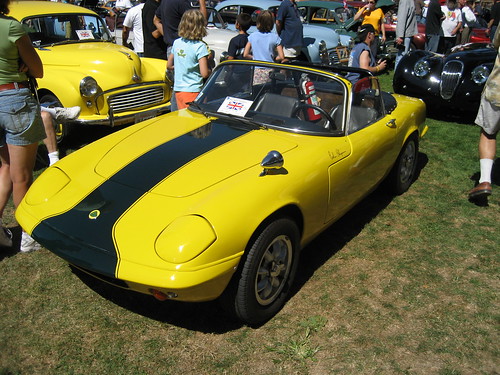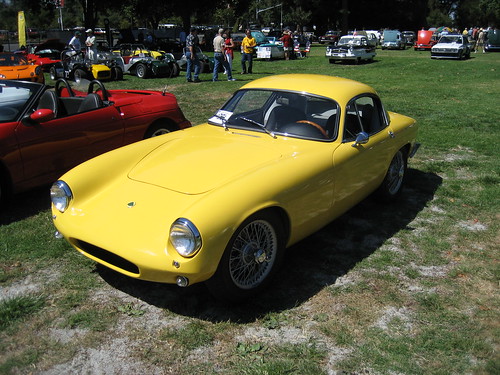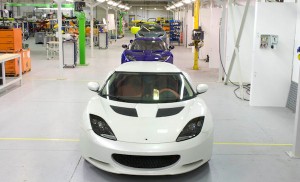Evora UK options and pricing
Evora 2+0 £ 47,500
Evora 2+2 £ 49,875
Tech Pack £ 2,495
Sport Pack £ 950
Premium Pack £ 2,495
Metallic Paint £ 538
Lifestyle Paint £ 979
Premium Paint £ 1,957
Powerfold Door Mirrors £ 300
Bi-Xenon Headlamps £ 550
Alpine/Lotus IMPRINT Sound £ 1,495
Alpine Reversing camera £ 300
Stealth Grey cast alloy wheels £ 300
Silver forged alloy wheels £ 1,495
Gloss Anthracite forged alloy wheels £ 1,795
Sports ratio 6-speed manual transmission £ 1,495
Full Press release below
First deliveries of the eagerly anticipated Lotus Evora will be made to customers in Europe in May 2009 following an extensive and rapid development programme, enabling the whole project to be completed in an extraordinary 27 months, almost unprecedented in the motor industry.
The Lotus Evora Launch Edition
The first 450 cars will be built to a high level standard specification which includes the following equipment:
? 2+2 seating configuration
? Tech Pack
? Premium Pack
? Sport Pack
? Hi-power silver cast alloy wheels
? Bi-Xenon Headlamps
? Alpine Imprint Audio System
? Reversing Camera
? Electric Powerfold Mirrors
The Launch Edition includes either Ardent Red or British Racing Green as standard, and all other colours from the Lotus range are available as a cost option.
Following on from these first 450 Lotus Evora Launch Edition sportscars, customers will have the opportunity to spec to a more personal level – but of course they will not be part of the select few who will be among the first to own Britain’s latest sportscar and one of the most anticipated cars of the year, complete with a unique Evora commemorative build plate in the cabin.
The Lotus Evora in Summary
The Lotus Evora will enter the sportscar market as the only mid-engined 2+2 in production. The new car is a more holistic offering than the Elise, Europa and Exige models that have been so massively popular and iconic. The Lotus Evora is designed for people who desire exotic sportscar characteristics of stunning design, exclusivity, dramatic proportions and performance. However, it offers real-world usability and a unique sense of occasion. Powered by a 3.5-litre V6 producing 280 PS and 342 Nm of torque, the new car employs innovative lightweight chassis technology to ensure all-round dynamic performance, in keeping with the great Lotus tradition.
Straight line performance is spectacular, with the zero to 100 km/h sprint taking place in just over 5 seconds with a top speed of over 260 km/h (prototype figures). Economy and emissions figures are class leading with the Official European Combined Cycle fuel economy being just 8.7 litres / 100 km and the emissions being just 205 g / km CO2. The other fuel economy figures are equally impressive with Official European Urban Cycle figures of 12.4 litres / 100 km and 6.5 litres / 100 km for the Official European Extra Urban Cycle.
Inside, the Lotus Evora cocoons occupants with sumptuous leather surfaces juxtaposed with contemporary high-tech features. With driver focused instrumentation the occupants sit in cockpit-esque surroundings. A beautifully appointed dash boasts tactile details such as flush-mounted controls that glow with blue LED haloes and a stylised speedometer and rev counter ensuring that controls are both attractive and accessible. Styled in-house by Lotus Design, the Evora’s sophisticated and attention-snaring lines brilliantly disguise its ability to accommodate passengers in the rear of the cabin, giving the car the external characteristics of a small, nimble sportscar belying its real exterior and internal space. As well as being sold in a 2+2 configuration, the car will also be available as a two-seater, the space in the rear being allocated to luggage storage. Other derivatives are also planned for the long term future, including a convertible and a version with automatic transmission.
The first production Lotus Evoras have already started down the assembly line at Lotus’ high tech manufacturing facilities in Worcester UK (where the advanced extruded and bonded aluminium chassis is made) and at the Lotus Headquarters in Hethel UK. Build volumes are expected to ramp up steadily over the next few months with a target of 34 Lotus Evoras being made each week by July 2009. This manufacturing volume is in addition to the current build volume for Lotus small car platform vehicles (Elise, Exige, Europa and 2-Eleven) of 44 per week building to 55-60 per week in the run up to the northern hemisphere summer.
For peace of mind, the Lotus Evora has a 3 year 100,000 km (60,000 miles) whole vehicle warranty with an 8 years chassis perforation warranty for EU markets.
Full standard equipment, together with the Manufacturer’s Suggested Retail Prices for the Lotus Evora and the cost option equipment are listed below:
Lotus Evora Standard and Cost Option Equipment
| S – Standard O – Cost option | |
| Engine and transmission | |
| 206 kW (276 hp, 280 PS) 3.5 litre V6 engine with VVT-I | S |
| 6-speed manual transmission | S |
| Sports ratio 6-speed manual transmission | O |
| Optimal gear shift-point display | S |
| Twin polished exhaust tailpipe | S |
|
Handling technology |
|
| Fully independent suspension layout | S |
| Forged aluminium unequal length double wishbones with integral joint | S |
| Bilstein mono-tube gas dampers (front and rear) | S |
| Eibach coaxial coil springs (front and rear) | S |
| Anti-roll bars (front and rear) | S |
| Yokohama Advan Sport LTS tyres (225/40 ZR18 front and 255/35 ZR19 rear) | S |
| Hydraulically-assisted power steering | S |
| BOSCH Electronic Differential Lock (EDL) | S |
| Switchable traction control | S |
|
Safety |
|
| Lotus lightweight deformable bonded front structure | S |
| Lotus all-aluminium safety monocoque ‘tub’ | S |
| Lotus welded galvanised deformable rear structure | S |
| Lotus side impact safety structure | S |
| Stainless steel fuel tank, sheltered within safety shell | S |
| 2-stage airbags for driver and front passenger | S |
| Isofix child seat fastening system in the rear | S on 2+2 seating configuration only |
| AP racing 4-piston fixed aluminium alloy 2-piece callipers | S |
| Ventilated brake discs (350 mm front and 332 mm rear) | S |
| BOSCH ABS with servo assisted brakes featuring
Hydraulic Brake Assist (HBA) Electronic Brake Distribution (EBD) |
S |
| Key located remote control central locking system and boot release | S |
| Immobiliser and key activated alarm | S |
| 3rd brake light – high mounted | S |
| Rear windscreen demister | S |
| Insulated double glazed rear window, filled with Argon | S |
|
Wheels |
|
| Silver cast alloy wheels (18″ front and 19″ rear) | S |
| Silver forged alloy wheels (18″ front and 19″ rear) | O |
| Stealth Grey cast alloy wheels (18″ front and 19″ rear) | O |
| Gloss Anthracite forged alloy wheels (18″ front and 19″ rear) | O |
|
Exterior equipment |
|
| Halogen headlights | S |
| Bi-Xenon headlights, incl. headlight washing system | O |
| Solar glass windscreen | S |
| Body coloured, heated, electric door mirrors | S |
| Body coloured, heated, electric, power-fold door mirrors | O |
| Aerodynamically optimised rear diffuser and wing | S |
| Body coloured door handles | O |
| Chrome brand and model designation badges | S |
|
Interior specification |
|
| Air conditioning unit | S |
| Adjustable Recaro Black leather sports seats (front). Recline tilt and slide | S |
| Flat-bottomed leather/magnesium steering wheel | S |
| Manual steering column adjustment for length and height | S |
| Bespoke aluminium illuminated control knobs and switches | S |
| Electric windows | S |
| Leather gear-knob | S |
| Leather handbrake sleeve | S |
| Remote release glove box | S |
| Door storage bins & integrated cup holders | S |
| 12-V interior accessory socket | S |
| 12-V boot mounted battery accessory socket | S |
| Lotus command centre with auxiliary trip computer | S |
|
Entertainment |
|
| Alpine CD/MP3/WMA receiver including: | S |
| 2x45W High Power Amp (6″ 1/4 coaxial 2-way speakers & dash mounted tweaters) | S |
| CD-R/-RW/MP3 Playback | |
| Full speed connection for iPod touch, iPod nano and all iPod models with dock connector | S |
| Full speed AUX input | S |
| Quick search | S |
| Lightweight fractal aerial | S |
| Tech pack | O |
| Upgraded stereo system with:
Alpine Mobile Media Station DVD±R/±RW/MP3/AAC/WMA/DivX Playback 2x50W High Power Amp (6″ 1/4 coaxial 2-way speakers & dash mounted tweaters) Alpine Lightweight amplifier with lightweight 150watt subwoofer 7″ WVGA Touch Screen display Alpine BlackBird Portable Satellite Navigation Bluetooth mobile phone connection USB connection for various iPod models and selected other MP3 player and memory sticks iPod connection and docking cradle in glovebox Full speed AUX input Quick search Cruise Control, included in steering wheel Rear parking sensors Tyre pressure monitoring system |
|
| Tech pack upgrades: | |
| Alpine/Lotus IMPRINT Sound with Specialised Advanced fine tuning
Optimisation of sound reproduction Enhanced sound staging and definition within the car |
O |
| Alpine Reversing camera (day & night) with 138 degree Field of View | O |
| Premium pack: | O |
| Accent lighting
Leather trimmed tailgate insert panel Evora Logo on dash Premium floor mats Choice of seat leather colour – Charcoal – Oyster – Paprika – Chestnut Leather door panelling below trim band Leather trimmed door pockets Leather footwell side panels Leather trimmed armrest Fully leather trimmed centre console |
|
| Sport pack: | O |
| Switchable sports mode featuring:
Enhanced Throttle response and RPM limit Sports traction control mode with increased yaw and slip thresholds Sports diffuser Titanium sports exhaust tailpipe Cross drilled brake disks Black painted brake callipers Engine Oil cooler** |
|
|
Paints |
|
|
Solid Paint |
S |
| Ardent Red
British Racing Green |
|
|
Metallic Paint |
O |
| Starlight Black
Liquid Blue Persian Blue Canyon Red Arctic Silver Storm Titanium Solar Yellow |
|
| Lifestyle Paint | O |
| Phantom Black
Aquamarine Laser Blue Isotope Green Carbon Grey Graphite Grey Chrome Orange Quartz Silver Aspen White Saffron Yellow |
|
|
Premium Paint |
O |
| Burnt Orange
Ice White |
|
| Warranty EU Markets | 3 year 100,000 km (60,000 miles) whole vehicle warranty. 8 years chassis perforation warranty. Customers statutory rights not affected. |
| MSRP : | ||||
| including local tax | ||||
| including transport | ||||
|
France |
Italy |
Belgium |
Switzerland |
|
| Evora 2+0 | € 61.189,– | € 61.874,– | € 61,809.– | CHF 93,241.– |
| Evora 2+2 | € 64.717,– | € 65.413,– | € 65,378.– | CHF 97,829.– |
| Tech Pack | € 3.508,– | € 3.519,– | € 3.549,– | CHF 5.228,– |
| Sport Pack | € 1.498,– | € 1.503,– | € 1.515,– | CHF 2.233,– |
| Premium Pack | € 3.005,– | € 3.015,– | € 3.040,– | CHF 4.478,– |
| Metallic Paint | € 995,– | € 998,– | € 1.007,– | CHF 1.482,– |
| Lifestyle Paint | € 1.859,– | € 1.866,– | € 1.881,– | CHF 2.771,– |
| Premium Paint | € 2.751,– | € 2.760,– | € 2.783,– | CHF 4.101,– |
| Powerfold Door Mirrors | € 291,– | € 292,– | € 295,– | CHF 433,– |
| Bi-Xenon Headlamps | € 995,– | € 998,– | € 1.007,– | CHF 1.484,– |
| Alpine/Lotus IMPRINT Sound | € 1.498,– | € 1.503,– | € 1.515,– | CHF 2.234,– |
| Alpine Reversing camera | € 593,– | € 595,– | € 600,– | CHF 892,– |
| Stealth Grey cast alloy wheels | € 553,– | € 555,– | € 559,– | CHF 825,– |
| Silver forged alloy wheels | € 2.000,– | € 2.007,– | € 2.023,– | CHF 2.985,– |
| Gloss Anthracite forged alloy wheels | € 2.764,– | € 2.773,– | € 2.796,– | CHF 4.122,– |
| Sports ratio 6-speed manual transmission | € 1.809,– | € 1.815,– | € 1.830,– | CHF 2.698,– |
| MSRP : | MSRP: | |||
| including local tax | excluding local tax | |||
| excluding transport | excluding transport | |||
|
Germany |
United Kingdom* |
Euro zone Countries |
||
| Evora 2+0
|
€ 59.990,– | £ 47,500.– | € 50.412,– | |
| Evora 2+2 | € 63.500,– | £ 49,875.– | € 53.361,– | |
| Tech Pack | € 3.490,– | £ 2,495.– | € 2.933,– | |
| Sport Pack | € 1.490,– | £ 950.– | € 1.252,– | |
| Premium Pack | € 2.990,– | £ 2,495.– | € 2.513,– | |
| Metallic Paint | € 990,– | £ 538.– | € 832,– | |
| Lifestyle Paint | € 1.850,– | £ 979.– | € 1.555,– | |
| Premium Paint | € 2.737,– | £ 1,957.– | € 2.300,– | |
| Powerfold Door Mirrors | € 290,– | £ 300.– | € 244,– | |
| Bi-Xenon Headlamps | € 990,– | £ 550.– | € 832,– | |
| Alpine/Lotus IMPRINT Sound | € 1.490,– | £ 1,495.– | € 1.252,– | |
| Alpine Reversing camera | € 590,– | £ 300.– | € 496,– | |
| Stealth Grey cast alloy wheels | € 550,– | £ 300.– | € 462,– | |
| Silver forged alloy wheels | € 1.990,– | £ 1,495.– | € 1.672,– | |
| Gloss Anthracite forged alloy wheels | € 2.750,– | £ 1,795.– | € 2.311,– | |
| Sports ratio 6-speed manual transmission | € 1.800,– | £ 1,495.– | € 1.513,– | |
All prices include first service and manufacturers warranty
All prices exclude on the road costs; on the road costs typically refer to registration, fuel, license plates, road tax, local dealer charges
* UK MRSP price – add £950 for on the road price
Lotus Evora:
205 g/km CO2
8.7 litres / 100 km (32.5 mpg) Combined Cycle
12.4 litres / 100 km (22.8 mpg) Urban Cycle
6.5 litres / 100 km (43.5 mpg) Extra Urban Cycle





